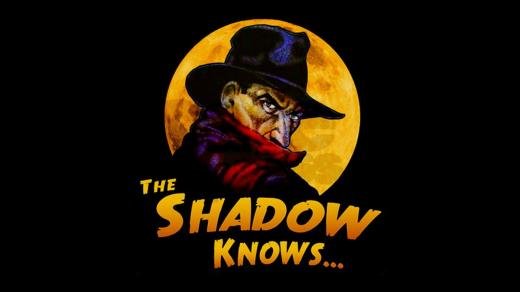The Shadow Old Time Radio detective thriller

The Shadow
“Who knows what evil lurks in the hearts of men? The Shadow knows!”
The opening lines of the The Shadow, one of the most popular radio shows in history, captivated listeners and are instantly recognizable even today. Originally the narrator of of series of macabre detective tales, the eerie voice known as The Shadow became so popular to listeners that “Detective Story” was soon renamed “The Shadow,” and the narrator became the star of the old-time mystery radio series that went on air in August of 1930 and ran until 1954.
Even now, many decades later, the unmistakable introduction from The Shadow radio program, originally intoned by actor Frank Readick Jr., has earned a place in the American idiom: “Who knows what evil lurks in the hearts of men? The Shadow knows!” These words were accompanied by a an ominous laugh and a musical theme, Camille Saint-Saëns’ Le Rouet d’Omphale (“Omphale’s Spinning Wheel”, composed in 1872). At the end of each episode, The Shadow reminded listeners, “The weed of crime bears bitter fruit. Crime does not pay…. The Shadow knows!”
Never seen but only heard, the Shadow was an invincible crime fighter. He possessed many gifts which enabled him to overcome any enemy. Besides his tremendous strength, he could defy gravity, speak any language, unravel any code, and become invisible with his famous ability to “cloud men’s minds.”
Along with his team of operatives, the Shadow battled adversaries with chilling names like The Black Master, Kings of Crime, The Five Chameleons, and, of course, The Red Menace. The Shadow’s exploits were also avidly followed by readers in The Shadow magazine, which began in 1931 following the huge success of the old-time mystery radio program.
The magazine was published by Street & Smith and, recognizing the demand and responding promptly, circulation manager Henry William Ralston commissioned magician Walter B. Gibson to begin writing stories about “The Shadow.” Using the pen name of Maxwell Grant and claiming that the stories were “from The Shadow’s private annals as told to” him, Gibson wrote 282 out of 325 tales over the next 20 years: a novel-length story twice a month (1st and 15th). The first story produced was “The Living Shadow,” published April 1, 1931.
Gibson initially fashioned the character as a man with villainous characteristics, who used them to battle crime. Clad in black, The Shadow operated mainly after dark, burglarizing in the name of justice, and terrifying criminals into vulnerability before he or someone else gunned them down. The character was a film noir anti-hero in every sense, likely inspired by mentalist Joseph Dunninger and illusionist Howard Thurston, both close friends of Gibson. Gibson himself claimed the literary inspirations for The Shadow were Bram Stoker’s Dracula and Edward Bulwer-Lytton’s The House and the Brain.
Street & Smith entered into a new broadcasting agreement with Blue Coal in 1937, and that summer Gibson teamed with scriptwriter Edward Hale Bierstadt to develop the new series. As such, The Shadow returned to network airwaves on September 26, 1937, over the new Mutual Broadcasting System. Thus began the “official” radio drama that many Shadow fans know and love, with 22-year-old Orson Welles starring as Lamont Cranston, a “wealthy young man about town.” Once The Shadow joined Mutual as a half-hour series on Sunday evenings, the program did not leave the air until December 26, 1954.
Welles did not speak the signature line of “Who knows what evil lurks in the hearts of men?” Instead, Readick did, using a water glass next to his mouth for the echo effect. The famous catch phrase was accompanied by the strains of an excerpt from Opus 31 of the Camille Saint-Saëns classical composition, Le Rouet d’Omphale.
After Welles departed the show in 1938, Bill Johnstone was chosen to replace him and voiced the character for five seasons. Following Johnstone’s departure, The Shadow was portrayed by such actors as Bret Morrison (the longest tenure, with 10 years in two separate runs), John Archer, and Steve Courtleigh.
Over the course of 18 years, Street & Smith published 325 issues of The Shadow, each one containing a novel about the sinister crime fighter. These stories were written by Maxwell Grant, a fictional name created by the publishing company. Although several different people wrote under the pseudonym, Walter B. Gibson wrote most of the stories, 282 in all.
Most of the novels published have been reprinted in paperback and The Shadow adventures remain popular today, with Shadow comic books, magazines, toys, games, cds and cassettes of old-time radio shows, and books bringing top dollar among collectors the world over.
The Shadow provided inspiration for another Old Time Radio classic, The Whistler, whose protagonist likewise knows “many things, for I walk by night. I know many strange tales, many secrets hidden in the hearts of men and women who have stepped into the shadows. Yes, I know the nameless terrors of which they dare not speak.”
Steven Dark
Host of dARk arTS Horror Radio – Broadcasting From Beyond the Grave 24/7/365 Vintage Old Time Radio Horror, Suspense and Macabre Mystery.
http://horror.radio
http://horror.radio

